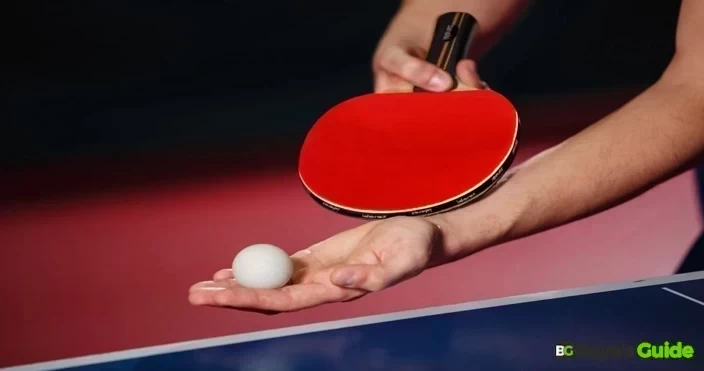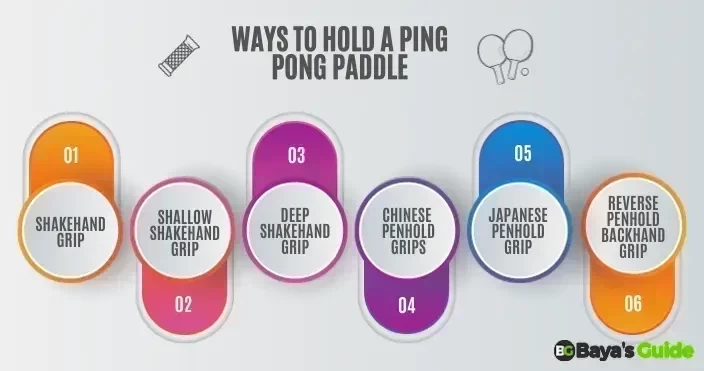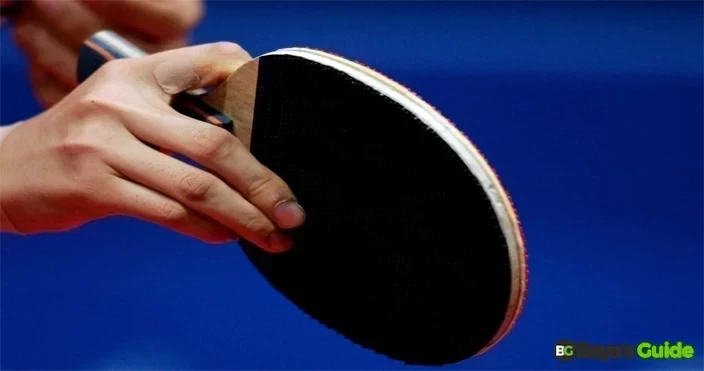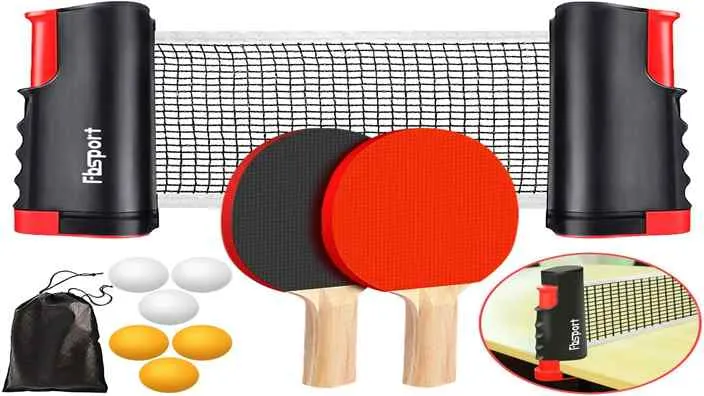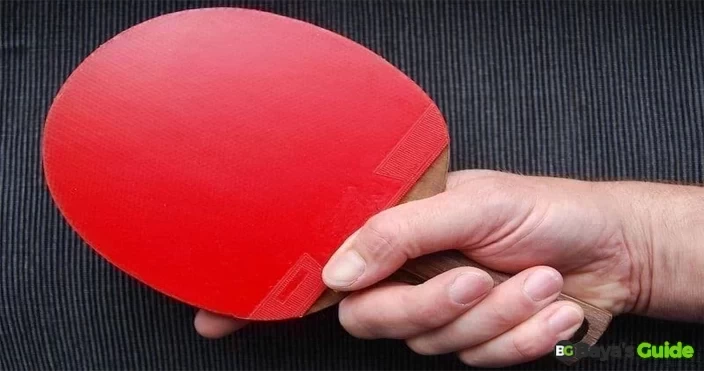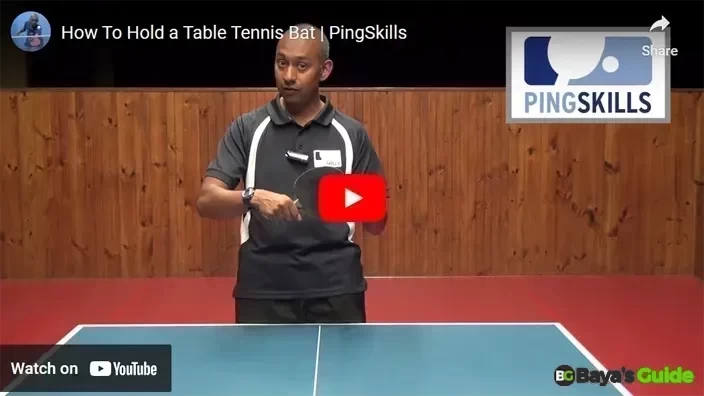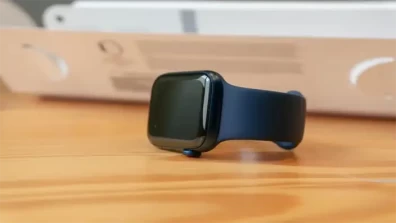The main grasp of the table tennis art is the grip of the ping pong paddle. While there's no single "correct" way to hold the paddle, two primary grips dominate the sport: shakehand grip and penhold grip. Every grip is unique and very distinct with its own advantages and unique grip styles so it is essential to learn the differences between both to determine the best one for you that matches your own personal taste and playing style.
Be prepared to go beyond the boundaries of the system to the territory where delicate finesse and power come together and strategies form a combination with skill. We’ll show you the essentials of a powerful grip, talk about the strengths of each one, and give you our opinion on which one works best for you and why. As such, hold on firmly, be focused, and let's take a dip into the world of ping-pong paddle mastery. Your next victory is just a well-held grip away!
Table of Contents
- 6 Proven Ways Of Holding A Ping Pong Paddle
- Portable Table Tennis Kit - Includes Retractable Net, 2 Paddles, 6 Balls, & Carry Bag For Indoor/Outdoor Fun - Suitable For Children & Adults
- Tips For Holding A Ping Pong Paddle
- Illegal Ways to Hold a Ping Pong Paddle
- Frequently Asked Questions
- What Is The Professional Way To Hold A Ping Pong Paddle?
- Which Is The Best Grip To Hold A Ping Pong Paddle With?
- Is There A Wrong Way To Hold A Ping-Pong Paddle?
- What Is The Best Way To Hold A Table Tennis Racket?
- What Are The Three Ways Of Holding A Table Tennis Racket?
- How To Hold A Table Tennis Racket As A Beginner?
- Conclusion
6 Proven Ways Of Holding A Ping Pong Paddle
There are different ways, like the seemiller grip, to hold a ping pong paddle. But the most popular are the shakehand grip, Chinese penhold, and Japanese penhold. The shakehand grip is further divided into two types: the shallow grip and the deep shakehand. In addition, there’s another type of Chinese penhold grip, the reverse penhold backhand. Let’s discuss how to hold a ping pong paddle when serving with these different grips in detail, each with its pros and cons.
The Shakehand Grip
If you want to know the professional way to hold a ping pong paddle, the shakehand grip is the one. Its name is derived from how people shake hands because you hold it in the same position. To use it, first, you need to grip the handle with your ring, thumb, and middle finger, in addition to your pinky fingers. However, make sure you are keeping your index finger on the blade, fully extended like a pro!
In this grip, three fingers grip the handle, with the index finger touching the rubber edge. The blade’s edge rests in the hand’s V-shaped crease between the thumb and index finger.
Pros
- It provides great wrist flexibility and control.
- Allows to hit a variety of shots with forehand and backhand.
- It is an ideal position for defensive shots.
Cons
- This grip type is not for beginners.
- It limits the ability to make low backhand shots.
- Smart opponents can take advantage by placing the ball in the “crossover point.” It is a tricky spot in front of you where choosing between a forehand and backhand shot is hard.
The Shallow Shakehand Grip
In the shallow shakehand, your hand is positioned with your thumb curled on the racket blade. This grip style is relaxed and natural for holding the paddle, making it easy to pick up for beginners.
Pros
- Good wrist flexibility.
- It feels comfy and natural in the hand.
- Effective for both backhand and forehand shots.
- Simple to fine-tune grip.
Cons
- Smart opponents can take advantage by placing the ball in the “crossover point.”
- It's not as easy for beginners as the deep shakehand grip.
The Deep Shakehand Grip
If you want to know how to hold a ping pong for beginners, the deep shakehand grip is the best. In this grip, your hand is higher up the handle, closer to the racket’s head. Your index finger stretches along the bottom of the racket while the thumb rests gently on the rubber.
The three lower fingers do the gripping. People who prefer control and precision over sheer power often use this grip. It'’s handy for shots needing precise control and less power, like chopping and blocking.
Besides, it works well for most forehand and backhand strokes, making it great for players who want to chop from both sides of their body.
Pros
- Easier for beginners.
- It feels comfy and natural to hold.
- Great for both backhand and forehand shots.
- More control and precision.
Cons
- Tougher to tweak the grip subtly.
- It's not so smooth when switching between grips.
The Chinese Penhold
If you want to learn how to hold a ping pong paddle in Chinese style, it is by holding the paddle like a pen, with the handle up and the paddle surface down. The handle fits in the V of your hand, and your thumb and index finger grip the top.
You hold the blade downward using the index finger and thumb. This is a forehand grip for left-hand players where your other three fingers curl gently along the back of the paddle. You only utilize the forehand rubber if you’re a left-hand player. To switch to the backhand side for right-handed players, turn your forehand rubber 180 degrees to the left.
Pros
- This grip offers ample wrist flexibility, aiding spin and power.
- It excels at blocking and chopping shots.
- It’s versatile for forehands, backhands, and serves, with no crossover problem.
Cons
- Some shots, like topspin backhands, can be tricky.
- You need solid footwork skills.
- Learning and mastering this can be challenging.
The Japanese Penhold
Also called the Korean penhold, in this grip, you place your index finger and thumb in the same way as in the Chinese penhold. But instead of curling your three remaining fingers, you extend them straight along the back of the paddle. Japanese penholders use their forehand rubber on the backhand side. To make the most of this grip, you’ll have to work on your footwork to execute standard forehand strokes whenever possible.
Pros
- Ideal for players who rely more on forehand strokes.
- Your wrist can move freely from left to right along the blade’s edge.
- No crossover issue.
- It's more comfortable than the Chinese penhold.
Cons
- Extended fingers limit blade movement from handle to top.
- Consistent backhand topspin is challenging.
- Demands quick footwork and endurance.
You Might Also Like:How To Play Spike Ball
Portable Table Tennis Kit - Includes Retractable Net, 2 Paddles, 6 Balls, & Carry Bag For Indoor/Outdoor Fun - Suitable For Children & Adults
About This Item
- Retractable Ping Pong Net - Enjoy pro-level matches with our retractable ping pong paddle set, featuring a durable mesh net.
- Portable Play Anywhere - Attach the net to tables below 5cm thickness for instant gameplay, retracting effortlessly after use.
- Portable Ping Pong Paddle Set - Includes 2 high-performance paddles, a retractable net, and 6 balls—ideal for spontaneous play anywhere.
- Easy To Install - Attach the net to any supported table for easy installation, perfect for various occasions.
- Premium Quality - Quality paddles with solid wood and durable rubber surfaces, plus weighted ping pong balls for a pro-level game. Questions? Feel free to reach out.
The Reverse Penhold Backhand (RPB) Grip
This grip solves the issue of the Chinese penhold. In RPB, you switch to a regular backhand instead of the inverted forehand for the backhand shots. So, if you’re a Chinese penholder, it’s undoubtedly the best way to grip your ping pong paddle.
Pros
- It makes it simpler to start topspin.
- Boosts your backhand power.
- It works well for serving.
- It offers excellent wrist flexibility for adding spin.
Cons
- Less reach on the backhand side.
- Has a crossover issue.
- It's not effective for defensive moves like blocking and chopping.
Tips For Holding A Ping Pong Paddle
| Grips | Descriptions |
| The Shakehand Grip | Professional grip provides wrist flexibility and control, but is challenging for beginners and limits low backhand shots. |
| The Shallow Shakehand Grip | Relaxed grip with curled thumb, suitable for beginners but vulnerable to smart opponents targeting the "crossover point." |
| The Deep Shakehand Grip | Grip further up the handle, offering control and accuracy but challenging to change grips smoothly. |
| The Chinese Penhold | Grip resembling holding a pen, comfortable with wrist flexibility but challenging for certain shots, requiring stable footwork skills. |
| The Japanese Penhold | Grip with extended fingers along the back, ideal for forehand strokes but demanding swift footwork and endurance. |
| Reverse Penhold Backhand (RPB) Grip | Grip enhances backhand power but reduces reach and effectiveness for defensive movements. |
Illegal Ways to Hold a Ping Pong Paddle
Some ways of holding the paddle are considered unethical and unsportsmanlike in the world of ping pong, such as:
1- Two-Handed Grip
Holding the paddle with both hands is seen as unfair since it provides extra power and control.
2- Table Wedging
When players wedge the paddle against the table, it creates a “trampoline” effect, making it easier to hit the ball, which isn’t seen as sportsmanlike.
3- Death Grip
Holding the paddle too tight limits wrist movement, affecting power and spin.
4- Butterfingers
Holding it too loosely can send your paddle flying mid-shot.
5- Finger Fumble
Incorrect finger placement messes with your grip. Keep your thumb and index finger close, with the others wrapped around.
6- Twisting
Over-rotating the paddle in your hand makes control a challenge.
7- Stiff Wrist
A rigid wrist won’t help you crank up the power and spin. So, keep your wrist loose.
Frequently Asked Questions
What Is The Professional Way To Hold A Ping Pong Paddle?
The most professional way to hold a ping-pong paddle is by using three fingers to hold the handle, with the index finger touching the rubber edge. The blade’s edge rests in the hand’s V-shaped crease between the thumb and index finger.
Which Is The Best Grip To Hold A Ping Pong Paddle With?
The best ping pong grip is the shakehand grip. It’s excellent for backhand and forehand strokes and is the favorite of many top players globally, like Timo Boll, Ma Long, and Zhang Jike.
Is There A Wrong Way To Hold A Ping-Pong Paddle?
There isn’t a strictly “wrong” way to hold a ping-pong paddle, but some grips work better for power and control. The shakehand grip is the most popular one, as it’s versatile and works well for different shots.
What Is The Best Way To Hold A Table Tennis Racket?
The best way to hold a table tennis racket depends on your expertise. If you’re a beginner, the deep shakehand grip is ideal, and if you’re a pro, the traditional shakehand grip is best for you.
What Are The Three Ways Of Holding A Table Tennis Racket?
The three most popular ways of holding a table tennis racket are the shakehand grip, the Chinese penhold, and the Japanese/Korean penhold.
How To Hold A Table Tennis Racket As A Beginner?
To hold the table tennis racket as a beginner, place your hand higher up the handle, closer to the racket’s head. Your index finger should stretch along the bottom of the racket, and the thumb should rest gently on the rubber. The three lower fingers should do the gripping.
Conclusion
So there you have it - the lowdown on how to hold a ping-pong paddle. Remember, your gameplay is pretty much tied to how you grip that racket in ping pong. Whether you’re a casual player or aiming for the championship, the proper grip can make all the difference.
We’ve covered the three most popular types of grips above the shakehand, Chinese penhold, and Japanese penhold, and when to use them. But make sure not to hold the racket in an unsportsmanlike and unethical way. Swing it like a pro and watch your game improve vastly!

